The Leading Edge: January 2024 Wind Energy Newsletter
In this issue, we say goodbye to an old research turbine, congratulate prize winners, and reveal a researcher’s mischievous childhood dream job. We also share NREL’s latest wind energy news, opportunities, and publications.
Upwind: Featured News
Say Goodbye to an Old Workhorse and Hello to New Distributed Wind Research Capabilities
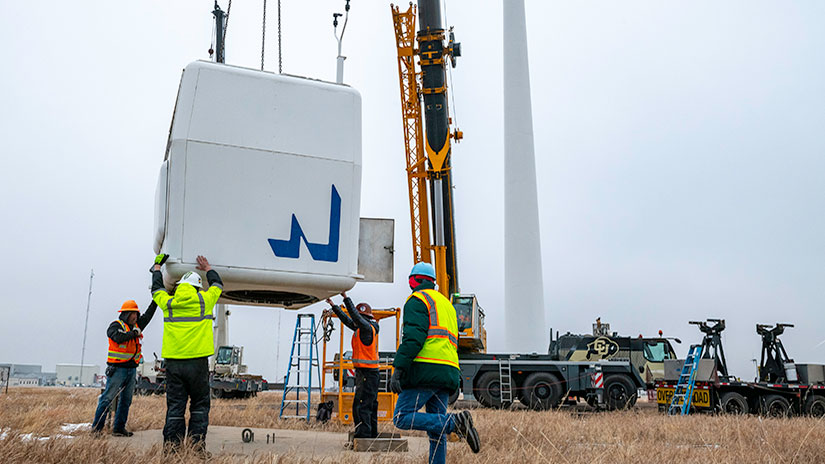
The National Renewable Energy Laboratory (NREL) recently bid farewell to a 100-kW distributed wind turbine prototype on NREL’s Flatirons Campus. The turbine’s removal signals the beginning of new, expanded distributed wind research capabilities for the laboratory.
The first true cold-weather turbine, Northern Power Systems’ NorthWind 100 wind turbine arrived at NREL in 2001 and was used for a variety of wind energy research projects.
Where the NorthWind 100 turbine once stood, NREL will install and commission a new distributed wind turbine in early 2024. That turbine will be one of three modern distributed wind turbines that will connect to the new Flatirons Campus Distributed Integrated Energy Laboratory, which will enable NREL researchers to study how the turbines interact with the power grid.
Twenty Teams Win First Phase of Wind Turbine Materials Recycling Prize
Twenty teams from across the country submitted winning solutions in the first phase
of the Wind Turbine Materials Recycling Prize. Graphic by John Frenzl, NREL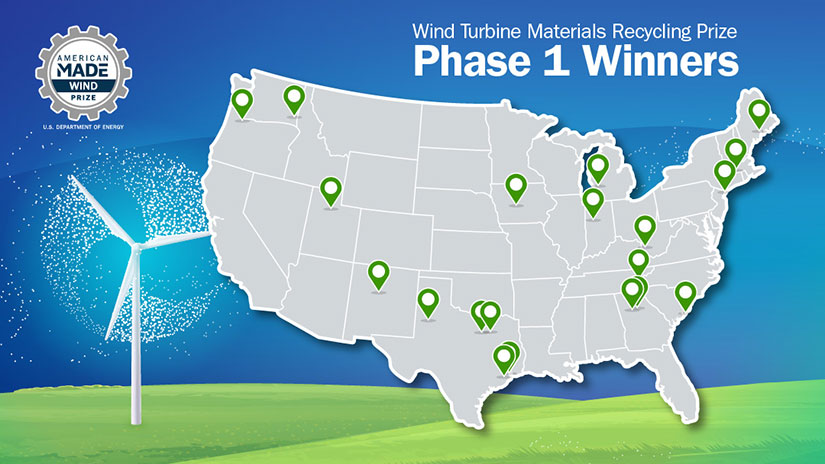
The U.S. Department of Energy (DOE) recently announced the 20 winners of the first phase of the Wind Turbine Materials Recycling Prize. Administered by NREL and part of the American-Made Challenges Program, this $5.1 million, two-phase competition aims to advance the development of a cost-effective and sustainable U.S. recycling industry for two high-impact categories of wind turbine materials: fiber-reinforced composites and rare earth elements. The 20 winning teams from 15 states each received $75,000 and an invitation to advance to Phase 2, where they will develop prototypes of their technologies and compete for the chance to win a cash prize of $500,000 and vouchers valued at $100,000 to work with DOE national laboratories.
Behind the Blades
Why Genevieve Starke Gave Up on Her Childhood Dream
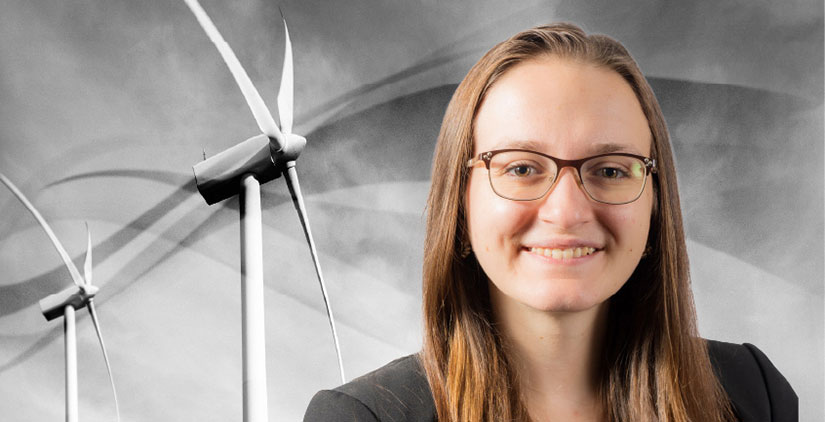
As a kid, Genevieve Starke dreamed of becoming a con artist. Inspired by the 1973 hit movie "The Sting," she wanted to orchestrate fraudulent schemes for a living, just like Robert Redford and Paul Newman’s characters.
“That dream died when I found out I’m not super good at breaking rules,” Starke said.
Naturally, the little girl from Pennsylvania decided to pivot her dream to a field where rule-following was a little more appreciated. She picked engineering.
Now a research engineer at NREL, Starke gets to follow a whole lot of rules. But she also gets to write some new ones.
“When you’re doing research, you’re frequently doing things that haven’t been done before,” Starke said. “So there are no instructions or rules to follow—you have to come up with them.”
Starke earned her doctorate at Johns Hopkins University, where she researched how groups of wind turbines interact with the wind and one another. She also studied wind farm control systems, which are like the brains of wind turbines. They adjust different parts of wind turbines, such as blade angles or the direction a turbine is facing, to change the behavior of the wind farm.
Now, Starke is developing the same models she once used during her graduate research. But she has expanded her research beyond wind energy. She currently works on hybrid energy systems models, which help determine how renewables such as wind, solar, and hydrogen can be integrated into the grid safely, affordably, and reliably.
“It’s been strange to go from someone who runs models to someone who makes models,” Starke said. “Suddenly, you’re the one making all the decisions!”
We caught up with Starke to learn more about her life—within NREL and outside of work. Read the full Q&A to learn what she shared.
On the Radar: Project Updates
Offshore Wind Energy Study Paves the Way for Clean Energy Expansion in the Gulf of Mexico
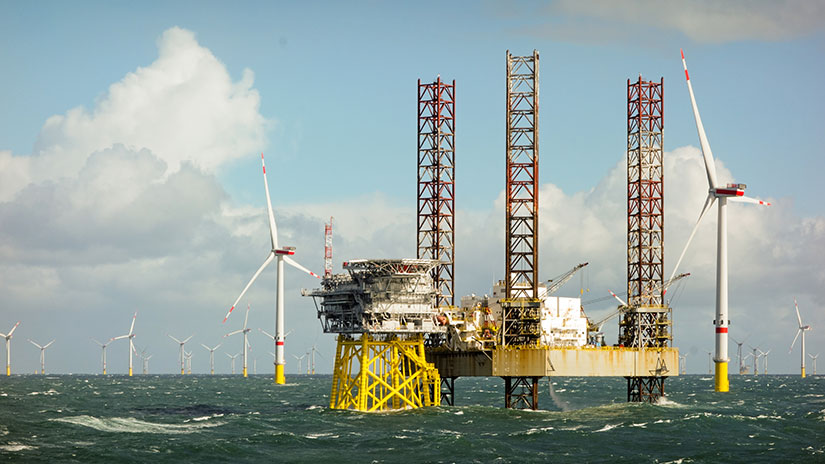
Unlocking the potential of offshore wind energy in the Gulf of Mexico could play a vital role in the pursuit of U.S. carbon neutrality by 2050. A recent study by NREL, commissioned by the Bureau of Ocean Energy Management, addresses technical challenges and highlights engineering solutions to harness clean energy. The report delves into aspects such as wind resource assessment, hurricane-resistant turbine design, insurance considerations, and regional infrastructure. Despite recent auction challenges and economic uncertainties, particularly in the summer of 2023, the findings emphasize the importance of addressing complexities such as low wind speeds and hurricane risks. This study provides crucial insights for federal and Gulf state energy planning that could impact offshore wind development in the Gulf and contribute to broader U.S. clean energy goals. Scheduled to be released by NREL in April 2024, a national assessment of offshore wind energy costs will include a comprehensive cost assessment for the U.S. Gulf of Mexico.
Downwind: In Case You Missed It
Twelfth Annual Review Unveils New Insights Into Costs of Wind Energy
NREL has published the 2022 Cost of Wind Energy Review, which offers a comprehensive analysis of the levelized cost of energy (LCOE) for wind energy projects in the United States. Based on 2022 data, the review covers representative land-based and offshore wind installations, including fixed-bottom and floating offshore structures. The review also includes updated LCOE estimates for residential-, commercial-, and large-scale distributed wind projects as well as sensitivity analyses showing the range of effects that basic LCOE variables could have on the cost of wind energy for land-based and offshore wind projects. New to the 2022 review are updated baseline values for the LCOE under the Government Performance and Results Act, cost reduction trajectories, 2035 LCOE targets for land-based wind energy and fixed-bottom offshore wind energy under the Government Performance and Results Act, and the estimated relative value of manufactured product components for land-based wind energy. The review offers a significant resource to help stakeholders, policymakers, and the renewable energy industry support cost-effective wind energy development.
New Offshore Wind Dataset Redefines U.S. Wind Energy Analysis
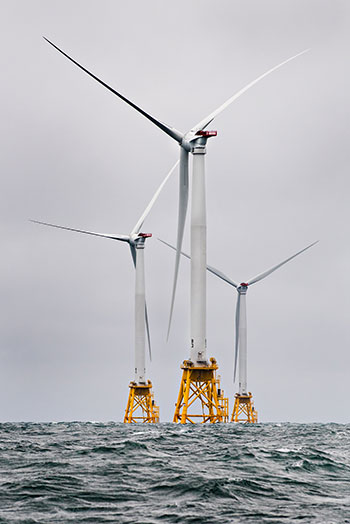
NREL recently released the 2023 National Offshore Wind dataset, the latest wind resource data specifically tailored for offshore regions in the United States. As described in the final report, the 2023 dataset offers output at 5-min time resolution and 2-km horizontal spatial resolution. In addition, the new dataset improves upon the offshore component of the previous resource, the Wind Integration National Dataset Toolkit, with a 20- to 23-year modeling period starting in 2000, region-specific sensitivity analysis, an upgraded Weather Research and Forecasting model, and the use of ERA5 reanalysis. Thanks to significant advancements in numerical weather prediction modeling over the past decade, the NOW-23 dataset incorporates the latest research and development progress to provide stakeholders with an updated, cutting-edge resource for offshore wind analysis.
Upcoming Events, News Mentions, Recent Publications
Upcoming Events
Wind Energy and Terrestrial Mammals
Feb. 5, 2024, 9–10 a.m. MT, Virtual
The International Energy Agency Wind Task 34, Working Together to Resolve Environmental Effects of Wind Energy, is hosting a webinar with presenters from Brazil, Portugal, and the United States to discuss how jaguars and pumas, wolves, and pronghorn antelope interact with wind energy facilities.
Floating Wind Solutions 2024
Feb. 5–7, 2024, Houston, Texas
On Feb. 5, 2024, DOE will host a panel discussion moderated by Jocelyn Brown-Saracino titled Floating Offshore Wind Shot Priorities, Progress, and Next Steps. This panel, led by DOE's Floating Offshore Wind Shot™ team, will showcase the significant achievements made in the first year of the initiative and how these accomplishments are helping drive the deployment of floating offshore wind technology. The discussion will also delve into how current work and feedback from stakeholders have informed priorities for future endeavors, which will guide federal efforts in the field over the next 2–3 years.
Distributed Wind 2024
Feb. 26–29, 2024, Arlington, Virginia
Register to join Distributed Wind 2024, hosted by the Distributed Wind Energy Association, to learn about new distributed wind energy technology and services and business opportunities from industry experts and federal leaders.
National Distributed Wind Network Webinar
March 14, 2024, 11 a.m. MT, Virtual
Are you considering wind to meet your local energy needs? To serve your business, farm, home, or community? Join us for this 1-hour webinar to learn about DOE’s new National Distributed Wind Network. A trusted source for information, the network will offer support and inspiration for distributed wind installation efforts nationwide through in-person and virtual events and best-in-class resources published on the newly established Distributed Wind Resource Hub. Register to attend the virtual webinar.
NREL in the News
Riding the Wind: How Applied Geometry and Artificial Intelligence Can Help Us Win the Renewable Energy Race, Zach Grey, National Institute of Standards and Technology, Jan. 10, 2024
What’s Next for Offshore Wind, Casey Crownhart, MIT Technology Review, Jan. 10, 2024
Getting More Offshore Wind Energy to Northern California and Southern Oregon, Clean Technica, Dec. 22, 2023
Bureau of Ocean Energy Management Announces Regional Environmental Analysis of Floating Wind Energy Development Offshore California, Perkins Coie, Dec. 21, 2023
Plant-Based Resin Could Make Wind Turbine Blade Recycling Cheaper and Simpler: NREL, Diana DiGangi, Utility Dive, Dec. 20, 2023
Behind the Scenes at a National Renewable Energy Laboratory Internship, Matilda Bathurst, University of Southern California Viterbi School of Engineering, Dec. 12, 2023
Offshore Wind Industry in U.S. Needs Supply Chain Investments, Laura Lightbody and Courtney Durham Shane, Pew, Dec. 12, 2023
Recent Publications
Resource Assessment
Assessment of Offshore Wind Energy Opportunities and Challenges in the U.S. Gulf of Mexico, NREL Technical Report (2023)
Capacity Density Considerations for Offshore Wind Plants in the United States, NREL Technical Report (2023)
National Wind Energy Workforce Assessment: Challenges, Opportunities, and Future Needs, NREL Technical Report (2024)
The 2023 National Offshore Wind Data Set (NOW-23), Preprint, Earth System Science Data (2023)
Technology
Base-Mediated Depolymerization of Amine-Cured Epoxy Resins, ACS Sustainable Chemistry & Engineering (2023)
Ensemble Flow Reconstruction in the Atmospheric Boundary Layer From Spatially Limited Measurements Through Latent Diffusion Models, Physics of Fluids (2023)
Want More?
Subscribe to The Leading Edge newsletter, and explore the latest news and accomplishments in wind energy at NREL.
Share

